Rhinoplasty - Nose Job in Turkey, Istanbul
Nose jobs, or rhinoplasty, are a popular cosmetic surgical procedure. Advancements in surgical techniques and technologies have made nose jobs safer and more effective than ever before. You can find detailed information about rhinoplasty in this article.
What is Rhinoplasty or Nose Aesthetics?
Nose aesthetics (Rhinoplasty) is the reshaping of the bone and cartilage structures of the nose to obtain an aesthetic appearance. It is one of the most frequently applied aesthetic operations in the world. Today, where facial appearance is important at all ages, a beautiful nose becomes indispensable for a beautiful face appearance. A nose that looks incompatible with the facial structure can cause psychological problems ranging from a decrease in self-confidence.
In rhinoplasty operations, it is aimed to correct the functional problems of the nose along with the correction of the aesthetic appearance. Difficulty breathing through the nose can turn into a problem that seriously affects the quality of life of the person in the later stages. During the rhinoplasty operation, the septum (middle part of the nose) curvatures that cause breathing difficulties and the excess of mucous-bone formations called concha are removed. At the same time, strictures that prevent airflow in the nose are eliminated, cartilage angles are arranged to provide the best airflow.
- Those who are uncomfortable with the aesthetic appearance of the nose
- Those who suffer from breathing problems
- People who do not have a serious health problem that may prevent surgery are candidates for rhinoplasty operation.

Before the surgery, the patient should express his/her expectations in the clearest way possible. The patient is informed in detail about the course of the surgery and the postoperative period. The patient should stop smoking at least 2 weeks in advance and also inform the physician about the drugs he uses. One day before or just before the operation, detailed photographs of the patient are taken and preparation for general anesthesia is made.
Rhinoplasty is an operation performed under general anesthesia. It can be done with open or closed technique. The difference between the open technique and the closed technique is that an incision of less than 0.5 cm is made on the skin under the nose. Around the 2nd month after the operation, almost no scar remains at the site of this incision. It is best to decide together with your doctor which technique is more suitable for you. The duration of the operation may vary between 2 and 4 hours depending on the procedures to be performed.
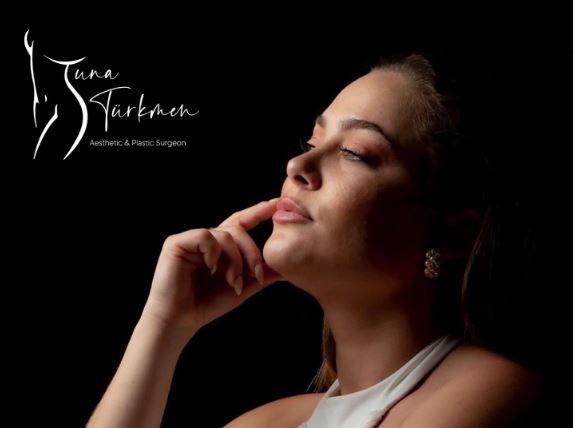
In general, those who are uncomfortable with the aesthetic appearance and structure of their nose, those who have difficulty breathing through the nose, etc. rhinoplasty operation is preferred.
What should be considered for a healthy and safe nose job surgery?
Although the length of stay after the operation varies according to the operations performed, it is usually 1 or 2 days.
As in any surgery, there are of course some risks in aesthetic nose operations. Although the risks associated with general anesthesia are also valid in rhinoplasty, there are some risks specific to rhinoplasty.
Patient dissatisfaction or some undesirable changes (mild asymmetries, persistence of breathing difficulty, low nasal tip, etc.) can be seen at a rate of 5-10% after nose surgeries. Some of these may require revision surgeries.
What is Rhinoplasty (Nose Job Surgery)?
An operation called a "nose job" is used to repair or remodel the nose. By changing the nose's size, shape, length, or other dimensions, rhinoplasty can improve the nose's look. Another method for adjusting the nostril or nose tip is surgery. Correction rhinoplasty, such as fixing a deviated septum, can help restore nasal functioning or lessen breathing issues brought on by nose injuries or abnormalities.
What are types of rhinoplasty
An method called "Open Rhinoplasty" is frequently used to change the contour of the nose.
With an open rhinoplasty, a small incision is made across the middle of the nose's base (the columella).The skin of the nose is then raised.Your Professional Plastic Surgeon can then see and immediately modify the underlying cartilage and nasal bones.Many tiny, extremely specialized instruments will be used by the surgeon during the surgery to sculpt and carve the underlying structures.
A Rhinoplasty procedure may occasionally be carried out using tiny incisions that are retained inside each nostril.The term "Closed Rhinoplasty" is frequently used to describe this method. A closed technique has the benefit of often hiding scars inside the nostrils. The drawback of this kind of surgery is that your surgeon has to work via a very small opening. This provides indirect and constrained access to the intricate internal components of the nose.
The Nose tip rhinoplasty can be improved cosmetically with rhinoplasty utilizing less invasive surgical methods. The specific goal of this technique is to produce a nasal tip that is symmetrical and has the proper projection, rotation, and proportion to the rest of the nose. Your surgeon reshapes or eliminates extra cartilage from the nose tip while leaving the bone structure of the nose unaltered. Next they could raise or refine the tip of your nose, as well as your nostrils.
Those who experience restricted air flow or who struggle to breathe through their nose may benefit from septoplasty surgery.
The septoplasty procedure enables your plastic surgeon to make corrections to the wall that separates the inner hard components of the upper section of the nose from the nostrils.
The internal structures of the nose can be repaired or a deviated septum can be fixed, both of which can have positive effects. Although not for everyone, septoplasty can reduce snoring in some people.
Enhancement or ethinization Patients from ethnic groups with weaker cartilage support for the nose and less pronounced nasal bridges are more likely to request rhinoplasty, which entails enhancing the projection of the bridge and the tip of the nose.
To produce a more refined nasal projection, this is usually paired with alar reduction (lower the width of the nostrils).
The materials used to support the tip and bolster the bridge may be synthetic or autologous (made from the patient's own bone or cartilage).
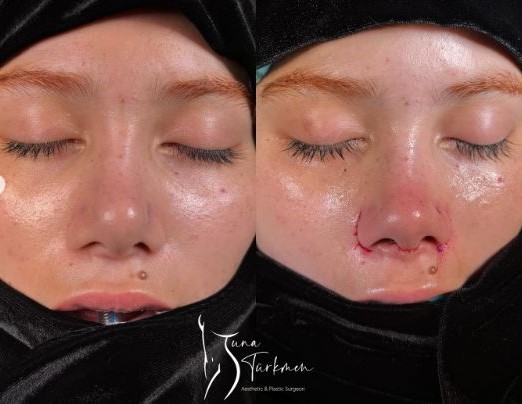

A lot of times, technical issues, healing issues, or injuries sustained during the first procedure cause the results of rhinoplasty to be undesirable.
The effort involved in a revision rhinoplasty cannot be understated, even if the region of concern frequently seems little. Even a minor repair necessitates a more involved surgical procedure than the first procedure and a lengthier postoperative recovery period.
Revision rhinoplasty involves skill and commitment from your surgeon as well as knowledge of the kinds of modifications that the initial procedure would have produced.
Am I a good candidate for Nose Surgery?

To achieve a more symmetrical, proportional, or facially balanced appearance, rhinoplasty surgery may be a viable option.
Most people who are dissatisfied with their nose's size, shape, or general look are interested in rhinoplasty surgery. You might want to look into surgical alternatives if you are really self-conscious about the way your nose or side profile look.
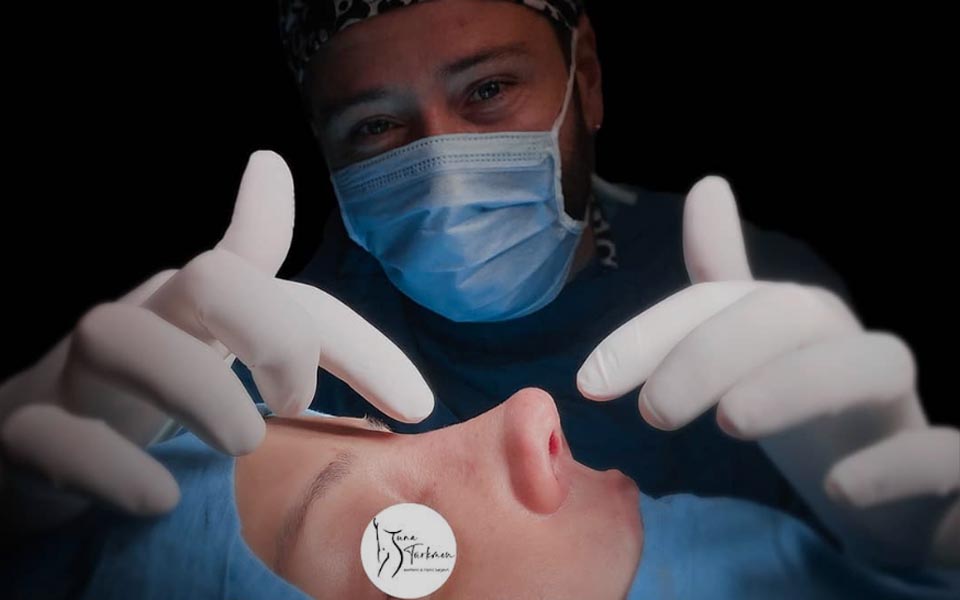
If you experience breathing issues, a deviated nasal septum, a collapsed nasal bridge, or certain types of sleep apnea, you may need corrective rhinoplasty methods (snoring).
You must have realistic expectations about what rhinoplasty surgery can and cannot accomplish in order to be a good candidate for nose surgery. When done by a highly qualified surgeon, nose surgery may enhance your nose's look, but it is unlikely to change your life. Requests for revisions are typical.
How to prepare for rhinoplasty surgery?
- It is a good idea to have a backup plan in case the backup plan fails. Take advantage of this opportunity to mentally and physically prepare yourself.
- Eat Healthily: Maintain a healthy, well-balanced diet to maintain your body in top physical condition. Maintaining healthy eating practices will increase your chances of a quicker and more comfortable recovery.
- Give Up Smoking: If you smoke, your cosmetic surgeon will ask you to stop for a while before your procedure. Take this advise seriously. Since nicotine reduces blood flow, there is a higher chance of surgical problems.
- Set Up a Comfortable Place for Recovery: If you'll be recovering at home, create a lovely environment where you can unwind peacefully. You'll need a couple pillows so you can support your head up, so make sure you have soft blankets on hand. To assist their recuperation be as peaceful and stress-free as possible, many individuals clean and tidy their homes before surgery.
- Get Assistance: You'll feel sleepy in the days after your rhinoplasty and require rest. If necessary, hire someone to assist you with home tasks like meal preparation and child care.
- Stock Up: Make a list of everything you’ll need during your recovery and shop for it ahead of time. Pick up any medical supplies and prescriptions your plastic surgeon gives you. You may want to make sure your Netflix subscription is paid up and grab a stack of magazines or a good book to keep you occupied during your recovery.
What are the steps of rhinoplasty surgery? How is rhinoplasty surgery performed?
- First step: Anesthesia
To help the patient rest throughout the surgical operation, sedation is often used in addition to local anesthetic.
- Step 2: The Incisions
Different incisions are used depending on whether a rhinoplasty is closed or open. During an open rhinoplasty, the columella—the tissue stub that separates the nostrils—is severed. Closed rhinoplasty involves discrete incisions made inside the nose to make smaller alterations to its shape.
- Step 3 - Monitoring
Throughout the treatment, your doctor may monitor your blood pressure and breathing rate to make sure your body is reacting to it as it should.
- Step 4 - Reshaping The Nose Structure
According to the pre-operative plans that were decided upon, the surgeon can alter the patient's nose. Removing bone or cartilage can help narrow a large nose. During surgery, it may be necessary to add cartilage from the ear or a piece of cartilage from the ribs.
- Step 5 - Closing The Incisions
Once the nose has been shaped into the proper shape, the surgeon will use microscopic sutures to close the wounds. To alter their size, further incisions may be made in the wrinkles that line the nostrils. Splints are usually used to protect the nose from accidental injury while it heals./p>
- Step 6: Recovering after a rhinoplasty
Patients should be prepared for some swelling, bruising, bleeding, and headaches for a few days following their surgery. Painkillers are prescribed by your doctor to help alleviate the discomfort you feel after surgery. You should go at least two weeks without doing anything physically demanding. You should avoid wearing glasses for up to six weeks following your procedure in order to protect your nose from abnormalities in the nasal bone that may require a revision rhinoplasty.
Please click here for more about "What are the steps of rhinoplasty surgery? How is rhinoplasty surgery performed?"What should I do after rhinoplasty?
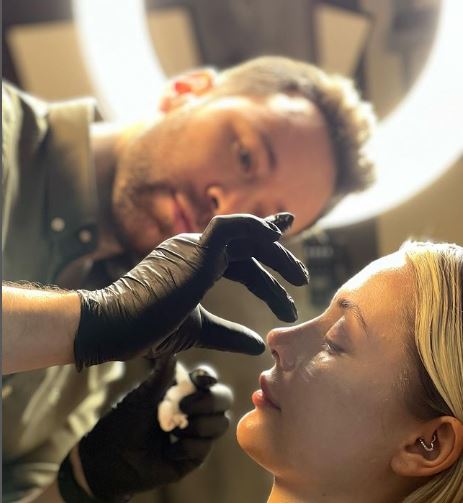
To guarantee a quick recovery and the best results from a nose job surgery, also known as a rhinoplasty, it's crucial to adhere to your doctor's post-operative recommendations. Following are some broad pointers that could be useful:
- Observe your doctor's recommendations: You'll receive detailed instructions from your doctor on how to take care of your nose following surgery. To lower the danger of difficulties, it is crucial to carefully follow these directions.
- Control your discomfort and swelling: After a nose job, pain and swelling are usual. To handle discomfort, your doctor can prescribe painkillers, and you might also get the go-ahead to apply cold compresses to minimize swelling.
- Relax and refrain from rigorous activity: During many weeks following surgery, it's vital to refrain from intense activities like exercise. Your body will be able to recuperate and the likelihood of problems will be lower.
- Maintain a raised head position: Maintaining an elevated head position, especially while sleeping, can help minimize swelling and accelerate recovery.
- For many weeks following surgery, refrain from blowing your nose since this might interfere with the healing process and could result in bleeding.
- Consume a balanced diet: Consuming a healthy diet can aid in the promotion of healing and lower the risk of problems.
- Attend follow-up visits: To track your recovery and look for any issues, your doctor will set up follow-up sessions. Attending these checkups and adhering to your doctor's advice are crucial.
Remember that every patient and their procedure are unique, so be sure to talk to your doctor about any particular instructions or worries.
Frequently asked questions
How much does it cost rhinoplasty surgery in Turkey?
There are additional costs to take into account, such as the scope of your treatment, your location, and the cosmetic surgeon you select. For instance, a little surgical reshaping of the nose takes less time during surgery and costs less than a total change in shape. A lengthier or trickier operation will often cost more money. Even though the majority of rhinoplasty surgeries are done as outpatient procedures, this is especially true if your circumstance necessitates an overnight stay. Revision rhinoplasty (done on individuals who have already undergone a nose operation) is typically more difficult and expensive than an original treatment.
The cost of your procedure will also depend on where you reside. In major urban areas and sparsely populated areas, as well as across cities, there are differences in the price of rhinoplasty. Two separate establishments may impose varying fees for their services even inside the same region.
The cost might also be impacted by the expertise and ability of the surgeon. A highly skilled surgeon with many years of expertise might demand a larger payment than a surgeon with less experience. The extra cost is more than justified since they can make sure that the best methods are applied to produce the desired outcomes. Never pick a surgeon solely primarily on price; doing so might leave you unhappy with the outcome of your procedure.
The majority of surgeons offer financing options available, which may include flexible monthly plans, if price is a concern for your rhinoplasty treatment.
Does nose surgery hurt?
During the first post-surgery healing phases, the majority of surgeries do cause some discomfort or pain. an oftas andaas and andasas and to and and andss of ad s. Pain following surgery is also quite subjective. Each patient experiences pain and suffering differently or more sensitively than another. Thankfully, by carefully adhering to your surgeon's advice and post-surgery instructions, the majority of discomfort you experience throughout your recuperation (especially immediately after your Surgery) may be controlled.
What actions may be performed to lessen suffering?
In order to facilitate your healing and rehabilitation, we will work with you to return as quickly as possible to your regular life.
Throughout your preoperative visits, surgery, and postoperative recovery, our surgeon is committed to keeping you as as ease as possible.
Patients are given a Post-Surgery Recovery Pack, which contains items that have been shown to hasten your recovery. Getting enough rest is also beneficial.
Is turkey safe for rhinoplasty? Why people go Turkey for rhinoplasty?
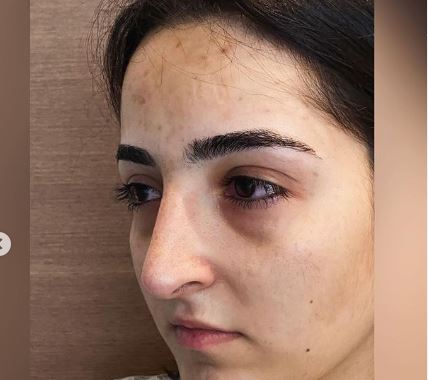

The nose can be reshaped through the common cosmetic procedure of rhinoplasty to enhance both its look and functionality. Because to the high standard of care provided by its medical facilities and qualified doctors, Turkey has grown to be a popular location for rhinoplasty surgery.
Turkey is typically regarded as a secure location for rhinoplasty surgery in terms of safety. With several recognized hospitals and clinics offering cutting-edge medical technologies and highly skilled surgeons, the nation boasts a well-established healthcare system. But, there are hazards associated with any surgical operation, so it's crucial to select a qualified and experienced surgeon and pay close attention to all post-operative instructions.
People travel to Turkey for rhinoplasty surgery for a variety of reasons. Cost is one of the main causes. Surgery for rhinoplasty is frequently far less expensive in Turkey than in other nations, especially in Europe and North America. Also, a lot of Turkish doctors are well renowned for producing top-notch outcomes and have vast expertise conducting rhinoplasty.
Many individuals decide to combine their rhinoplasty surgery with a trip in Turkey, which is a famous tourist destination. This enables patients to heal in a fun and entertaining setting while also learning about Turkey's fascinating culture and history.
Turkey is usually regarded as a safe and reliable location for rhinoplasty surgery, and many individuals prefer to travel there because of the great level of treatment and reasonable pricing, despite the dangers associated with any type of surgery.
When can I return to work after rhinoplasty?
Depending on the type of rhinoplasty treatment you had and the sort of employment you do, it might take a while for you to feel good enough to go back to work for other regular tasks like driving. Most patients discover 2- 3 weeks after surgery they are able to go back to work. If your job requires a lot of physical exertion, it can take longer for you to get back to work.If at all feasible, wait until 4 to 6 weeks have passed to ensure proper recovery.When you can resume work and other everyday activities your selected plastic surgeon will be able to provide you with personalized recommendations.
Will I need to stay in hospital overnight after rhinoplasty?
For the majority of rhinoplasty surgeries, an overnight hospital stay is often necessary. Patients can benefit from great post-operative treatment and monitoring thanks to this. Your surgeon will be able to provide advice as part of a surgical plan that is specially created for you.
Will I need to stop smoking prior to Nose Job surgery?
Smokers have a negative influence on their ability to heal. Smoking must be avoided by patients because it reduces the amount of oxygen that is transported by the blood to the skin and aids in the healing of surgical wounds. Smokers experience slower wound healing and more serious wound complications. If you haven't quit smoking yet, your surgeon will encourage you to do so at least six weeks before your procedure because doing so increases your chance of problems and poor recovery.
What can be done to minimise any post-surgery scars?
A tiny incision must often be made across the middle of the nose's base during an open rhinoplasty treatment, which may leave a faint but noticeable scar. However with a Closed Rhinoplasty, the only visible incisions are those that are placed inside the nostrils. As directed by your surgeon, wear your surgical tapes and splint and pay close attention to your post-operative instructions. Patients have access to scar minimization utilizing the Fraxel Laser, Dermapen, or Healite II Low Level Light Therapy as needed. Be sure to ask your surgeon of choice about the scar minimization methods available and the typical degree of scarring.
How long should I wait to return to exercise?
We usually suggest waiting at least 4-5 weeks before starting modest to intense kinds of exercise. But, before you resume any sort of exercise or other comparable activities, you must inform your surgeon. While you recuperate and rehabilitate, it's crucial to collaborate with your surgeon and keep them updated.
Will I need to wear a nasal splint after Surgery?
Your Surgeon will normally require you to wear a nasal splint for roughly 7-10 days following Surgery. Depending on the specifics of your case, this could take longer. Your nasal splint will aid in reducing swelling and stop the cartilage in your nose from moving. Your splint is an essential part of your recovery and will guarantee that you get the outcomes from surgery that were intended for you.
Is Rhinoplasty covered by health insurance?
Corrective nose surgery for breathing and appearance may be covered by insurance if you've already experienced a serious nasal trauma. Nevertheless, rhinoplasty, which alters the look of your nose, is typically not covered by insurance, particularly if you have no history of damage.
What is the best age for rhinoplasty?
Most girls and boys between the ages of 17 and 18 are physically mature enough for a rhinoplasty since their noses are the size of an adult. The timing of a rhinoplasty also depends on the patient's emotional development. Teenagers and young adults should view this treatment.
There is no established cutoff age for rhinoplasty for older patients. A senior adult in good health could be ideal for the surgery. Patients between the ages of 70 and 80 have had rhinoplasty procedures without major issues in certain instances. Patients between the ages of 20 and 40 are the best candidates for rhinoplasty since at this period, your face skin is still mostly elastic and can withstand surgical procedures without problems.
What is the success rate of rhinoplasty?
In reality, many people believe that rhinoplasty is the trickiest cosmetic treatment to do. Even a little alteration in the nasal profile necessitates a thorough comprehension of nasal anatomy, exact surgical technique, and awareness with the numerous possible complications-causing hazards.
To learn this difficult procedure, most surgeons must devote almost all of their time to its study and practice. For the same reason, rhinoplasty is also maybe the least often mastered of all cosmetic surgeries, and underappreciation of this demanding and difficult technique sometimes leads to naive or erroneous surgical tactics.
Furthermore, even if your local surgeon has a deservedly excellent reputation for other forms of cosmetic surgery, his or her proficiency with this highly specialized procedure can be far from state-of-the-art.
Rhinoplasty, also known as cosmetic nose surgery, has an estimated success rate of 85 to 90 percent, although this number could be higher if the procedure is carried out by board-certified plastic surgeons who specialize in this procedure. According to medical literature, the revision rate of Rhinoplasty is between 10 and 15 percent.
Will my breathing be affected by rhinoplasty surgery?
It is possible for the nose to enlarge for up to a year following surgery. Early on, this frequently causes some mild breathing difficulties, but these usually go away within one to three months. The majority of edema typically goes away six weeks following surgery, although it can continue up to a year.
You can use ice or ice packs to reduce any edema that may develop while you're recovering. This will reduce swelling and can be helpful if you have any breathing difficulties. Internal space opens up when internal swelling subsides, and breathing is significantly easier.
What can I expect during my rhinoplasty consultation?
The surgeon looks at both the inside and outside of the nose during a consultation for rhinoplasty. The respiration, cartilage, and bones are examined. A computer is used to take and subsequently display digital photos. The patient will be questioned by the surgeon about what they don't like about their nose.
The computer graphics will be altered in an effort to give the nose a better appearance. It is doubtful that the patient would be happy with the final results if the surgeon and patient cannot agree on how the nose should look through computer simulations. An operation is planned if the patient and the surgeon concur on the desired appearance of the nose.
What questions should I ask my surgeon before my rhinoplasty?
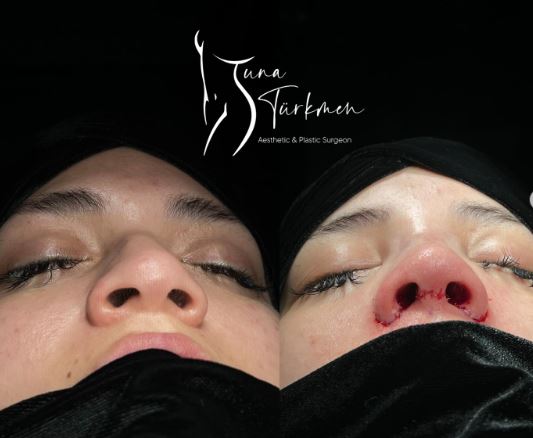

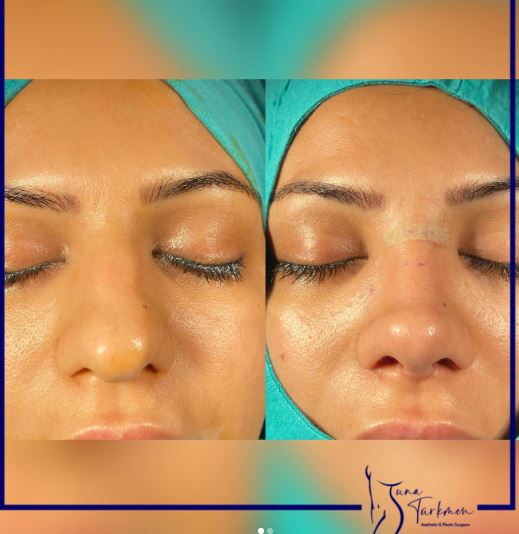
What is the difference between open and closed rhinoplasty?
The decision between open and closed rhinoplasty is possibly one of the most perplexing problems that a potential patient with rhinoplasty faces. While confusing, these phrases merely relate to the two potential surgical techniques, i.e., the access technique employed to allow exposure of the skeletal structure and temporarily remove the nasal skin.
Open Rhinoplasty - In contrast to the closed rhinoplasty, an open or external rhinoplasty procedure connects the right and left nostril incisions with a short bridge incision known as a trans-columellar incision. The nasal skin may be folded upward (similar to lifting a vehicle hood) in exchange for this 4-5 mm visible portion, allowing for clear sight of the lower nasal bone.
Nearly the whole nasal structure is directly visible, nasal cartilage distortion is reduced, and individual parts may be assessed in their undisturbed, natural alignment. Hence, the trans-columellar incision's substantially increased surgical access is the distinguishing feature of the open rhinoplasty.

Closed Rhinoplasty - Also known as endonasal rhinoplasty, the closed rhinoplasty technique places all surgical incisions inside the nostrils. Nevertheless, repositioning of the nasal skin is challenging since the right and left nostril incisions are still not joined, and the entire procedure must be carried out through small surgical apertures with poor sight.
Distortion of the nasal cartilage is also unavoidable because access to the nasal framework necessitates a forceful stretching of the nasal skin. Although a visible scar is avoided, the relative lack of surgical access is accompanied with significant difficulties and technological limits. Hence, the term "closed rhinoplasty" only alludes to the endonasal approach's relatively little surgical exposure.
What types of anesthesia are used during a rhinoplasty?
No matter the kind of anesthetic used, local anesthesia (lidocaine combined with epinephrine) is always used during rhinoplasty in order to numb the nose specifically and lessen any bleeding that may occur. Few surgeons employ local anesthetic alone, save for very minor alterations, because it is uncomfortable to administer the injection and challenging to complete a complex procedure on a fully conscious patient.
Without the use of a breathing tube, IV sedation relies on the expert administration of potent anesthetics through an intravenous catheter. This sort of anesthetic is often avoided by doctors during rhinoplasty surgery for a number of reasons. The patient must be rendered unconscious and immobile during IV sedation, but respiration should not be suppressed. The line between a patient being completely unconscious and breathing on their own and not being completely unconscious and experiencing abrupt movement or having the patient cease breathing due to too heavy sedation is delicate.
Moreover, bleeding happens throughout all rhinoplasty operations, so if the airway is not shielded by a breathing tube during surgery, there is always a risk that blood might drain back and be aspirated (inhaled) into the lungs. Finally, it can be particularly harder to keep patients comfortable with IV sedation for longer rhinoplasty procedures lasting several hours because patients may get restless, have muscular soreness, or have a full bladder.
General Anesthesia - The aforesaid issues stated up with IV sedation in rhinoplasty are best handled with general anesthesia. The most regulated environment is produced by general anesthesia during your rhinoplasty operation in several ways. The anesthesiologist can shield your windpipe from bleeding during surgery by managing the airway and inserting a breathing tube. You don't need to keep your own breathing going either since the anesthesiologist can totally control it using a breathing machine.
In order to lessen bleeding, bruising, and swelling, a deeper degree of anesthetic can be used, which can be regulated to keep the blood pressure low. Similar amounts of anesthetic are employed as with IV sedation since the local anesthesia injection leaves the nose relatively numb; as a result, the anesthesia's side effects are often minor and transient. The operating circumstances and surgical results can be significantly better in this more steady, regulated setting.
Can I drive home after my rhinoplasty?
After a nose job, you must not drive yourself. The first 24 hours following your rhinoplasty require someone to transport you home and stay with you, mostly because of the anesthetic but also because of the procedure itself. If it's feasible, you can also decide to spend the night at the hospital where the staff will take care of you.
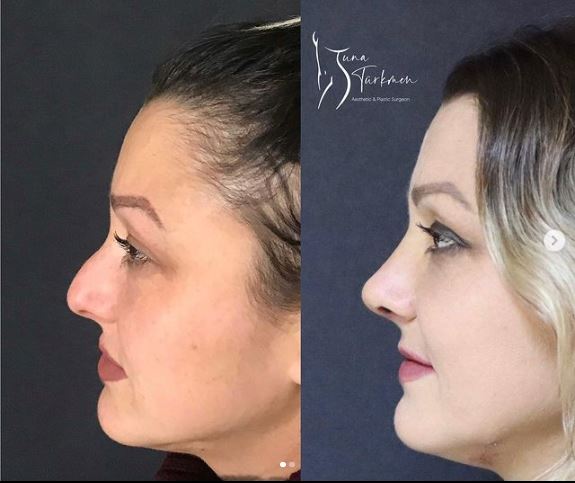
How should I sleep after my rhinoplasty?
The optimal position for your head and nose after rhinoplasty is above the heart, at least temporarily, in order to reduce swelling. If you have a reclining chair, it would be ideal to spend the first week or so following surgery sleeping in it. If it doesn't work, you might use some cushions to support your head. Along with reducing edema, sleeping in a midline position will also help you breathe more easily as you sleep.
It's time to go solo for a bit if you typically share a bed with your partner or spouse or even allow your pet. You don't want someone's hand or paw to unintentionally brush up to your nose. It wouldn't just be uncomfortable; it may also have an impact on how your operation turns out, which is something you don't want to chance.
Can I exercise after a rhinoplasty?
Before returning to vigorous exercise, head-down yoga poses, or basically any activity that is likely to raise blood pressure and cause flushing of the face, it is advised that patients wait two weeks. Walking and intimacy are both OK as long as you do it slow and don't slap your nose! You should normally wait a month to six weeks before engaging in any activity that entails extended submersion in water, significant pressure fluctuations, such as diving, or potential contact with the nose.
Why not work out straight after surgery? While the chance of any major bleeding is quite low and unlikely longer than a few days following surgery, we are not overly concerned about bleeding. Swelling is what we do want to avoid. The majority of the swelling subsides within a week, and modest exercise like walking helps to mobilize the fluid and hasten its drainage. But, too much exercise too soon after surgery can cause extra fluid to collect there, giving you the appearance of being more bloated.
When can I go back to work after my rhinoplasty?
If your job is sedentary and not physically demanding, you can immediately go back to work. You would still have bruises and bandages, though. Most patients don't leave their homes till the bandaging is taken off. Usually, that happens no later than a week following surgery. But, in many situations there is still bruising a week later. You might have to conceal for up to two weeks following surgery if you don't want your coworkers to know that you have bruises.
When can I fly after a rhinoplasty?
After surgery, a patient cannot fly for at least five days. While rare, it is avoided that you may get a nosebleed while flying, which could be life-threatening. Although it is still advised against flying for an extra week (a total of two weeks), many patients are unable to remain in the area for that long. Prior to takeoff, it's crucial to take Sudafed and spray a nasal decongestant (Afrin or another) if you have to fly during the second week of your recuperation. Otherwise, the pressure variations throughout the trip might be quite unpleasant. Following the flight, it is also common to experience additional swelling, which will continue for roughly 1-2 days.
When will I see the final results of my rhinoplasty?

Swelling and bruising are common side effects of rhinoplasty healing. They rely on a number of elements relating to the patient and the surgical procedure. Whether or not the nasal bones were shattered (osteotomies), the amount of soft tissue dissection/elevation from the bony-cartilaginous structure, and whether the operation was done open or closed are all techniques that exacerbate bruising and edema.
After a rhinoplasty, swelling subsides at varying rates. The nose is noticeably bloated and noticeable to everyone for the first two weeks. The nose normally seems "puffy" to the patient for several months after the second week, but the swelling often goes down to the point where it is not noticeable to a casual spectator that anything has been done to the nose. The bulk of swelling will typically go away by 4 months, but it may take a full year (or more in rare circumstances) for all of the edema to go away and the ultimate outcome to be realized.
How long should I wait after my rhinoplasty before I get a revision rhinoplasty?
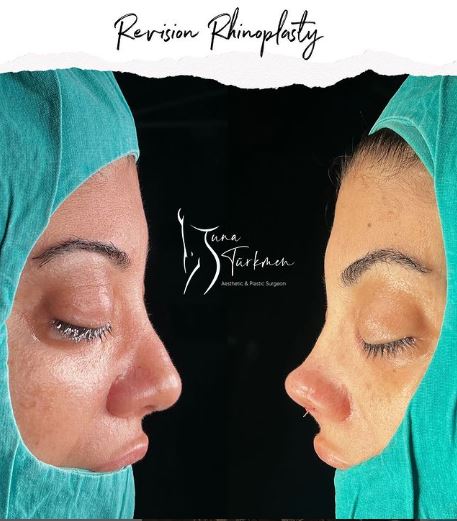
Due to the fact that it might take up to a year for the swelling to go down and the scar tissue to fully heal, the majority of rhinoplasty doctors prefer to wait until after that time period before conducting a revision rhinoplasty. A revision can frequently be avoided if certain issues that arise after rhinoplasty resolve over time. Other times, a year's worth of healing time may allow for other issues that weren't immediately noticeable during the initial period of recovery to surface, and all of the issues can be fixed with a single operation.
How long does it take for the swelling to go down after rhinoplasty?
When the dressings' compression is taken off after a week, there is typically a significant amount of swelling. The edoema really gets worse over the next few days when the compression of the dressings is removed.
The nose is very swollen, and after a week, there are often pen marks from the surgery or dried crusts. The patient may now thoroughly wash their face and take a shower, which is better.
After a month, the nose appears almost normal, so it's unlikely that your loved ones will even notice the difference.
After a year, the result is considered "final." However, keep in mind that the nose usually heals and changes very slowly. The effects of ageing will also become noticeable with time, which could change the conclusion slightly. On the other hand, a well-done rhinoplasty results in a nose that is built to last and doesn't usually need to be updated or revised.
Please click here to get more information about healing process.
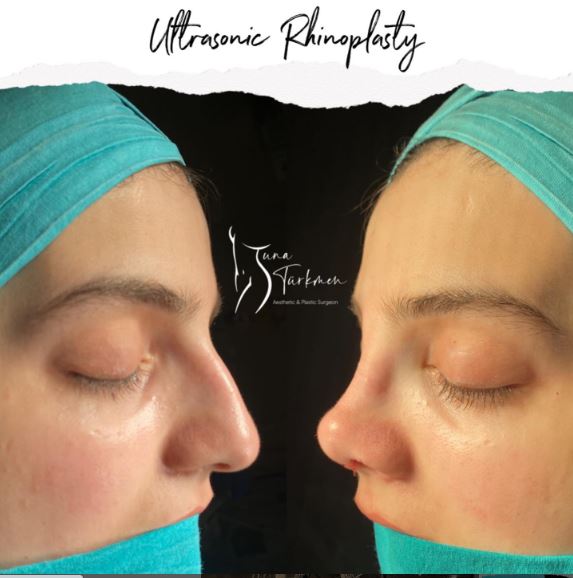
What are the potential side effects of nose surgery/rhinoplasty?
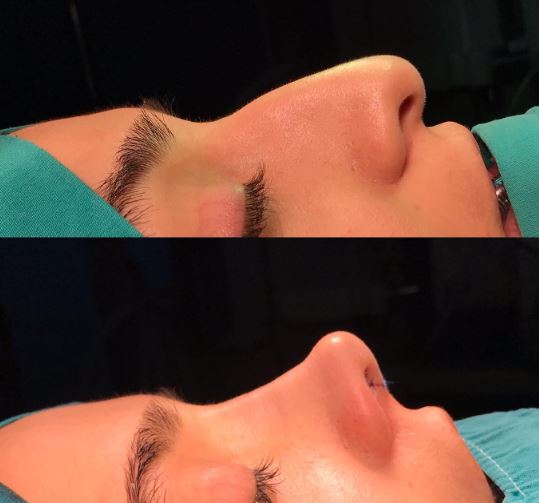
Rhinoplasty carries a few modest possible dangers, much like any other surgical or cosmetic operation. At the initial appointment, we will take the time to evaluate your nose and go through these possible hazards with you. The following is a list of some of the adverse effects you could experience during recovering.
Adverse reactions to anesthesia (it's vital to provide a thorough list of allergies before the treatment); discoloration and small swelling around the nose; various feelings including numbness, itching, or pain.
Nasal septal perforation (a tiny hole in the septum), which is unusual but usually manageable, infection if adequate aftercare is not provided, some scarring or redness, and the potential need for revision surgery (this is not uncommon)
Why is it so difficult to breath after my rhinoplasty?
The danger to a patient's ability to breathe following surgery is one of the most crucial factors that they must take into account while planning for a rhinoplasty or any other sort of nose surgery. There is always a chance that patients will have diminished breathing via their nose, whether temporarily or permanently, despite our best efforts to minimize any impact the operation may have on breathing. Almost all individuals experience nasal breathing difficulties following surgery.
This is a result of both the stitches and some nasal edema. After surgery, the mucus also doesn't travel around as it should, which might impair your ability to breathe. This normally returns to normal between the second and fourth week following surgery. Patients' concerns regarding long-term respiratory issues are understandable.
Each time you reduce the size of the nose, you run the danger of impairing nasal breathing. Despite our best efforts to avoid it, this is a side effect of cosmetic surgery. It is crucial to inform your rhinoplasty surgeon if you do experience breathing issues following surgery. This may frequently be enhanced and/or repaired.
How much is a rhinoplasty in Turkey?
Rhinoplasty surgery is often far less expensive in Turkey than it is in other countries, particularly in Europe and North America. Additionally, several Turkish physicians are well recognized for their exceptional results and extensive training in doing rhinoplasty.
Is it worth going to Turkey for a nose job?
Many people choose to combine their rhinoplasty procedure with a vacation to Turkey, a well-known travel destination. This allows patients to learn about Turkey's interesting history and culture while recovering in an enjoyable and engaging environment.
Even though there are risks involved with any kind of surgery, Turkey is generally thought to be a safe and dependable place for rhinoplasty surgery. In fact, many people choose to visit there because of the excellent level of care and affordable prices.
Is rhinoplasty 100% safe? and Is Turkish rhinoplasty safe?
Yes, in terms of safety, Turkey is thought to be one of the safest places for rhinoplasty surgery; however, it depends on the surgeon you choose.
How painful is a rhinoplasty?
Every patient has a unique way of feeling pain and suffering, or they may be more sensitive than others. Fortunately, most of the discomfort you feel throughout your recovery—especially in the early stages following your surgery—may be managed if you closely follow your surgeon's recommendations and post-surgery instructions.
How long does a nose job last?
After nose surgeries, 5–10% of patients experience unhappiness or certain unwanted modifications (such as moderate asymmetries, persistent breathing difficulties, low nasal tip, etc.). Revision operations might be necessary for some of these. The effects will usually endure a lifetime.
Does rhinoplasty leave scars?
During an open rhinoplasty procedure, a small incision must frequently be made in the middle of the nose's base, which could result in a subtle but noticeable scar. But with a closed rhinorrhinoplasty, the incisions inside the nostrils are the only ones that are visible.
What are the chances of a nose job failing?
Although rhinoplasty is normally a secure and safe procedure, problems or negative effects can continually arise. Risks related to rhinoplasties include bleeding, infection, damaging anaesthetic reactions, dyspnea, asymmetry, scarring, and dissatisfaction with the nose's look. Nonetheless, the majority of sufferers obtain the preferred outcomes, and the likelihood of full-size issues is generally minimal.
The achievement rate for rhinoplasty is generally between 90 and 95 percent, even though it may be better if the process is accomplished by plastic surgeons who specialise in this field. Op.Dr. Tuna Turkmen is one of the best surgeons in rhinoplasty surgery.
What are the alternatives to rhinoplasty?
There are no surgical substitutes for rhinoplasty. In certain cases, nasal airflow problems can be resolved with just internal nose surgery. Fillers are one example of a non-surgical treatment that can be used as a transient cosmetic treatment.
When can I shower after rhinoplasty?
Many patients should be able to take another shower 48 to 72 hours after their procedure. Their first few post-operative showers will be changed to prevent infection. Your doctor, however, is the one who will know best about bathing.
Note:
Please contact us for additional information or to schedule a consultation for rhinoplasty surgery.
This article is for informational and advisory purposes. The recommendations of your surgeon who will examine you and perform your surgery should be a priority.
